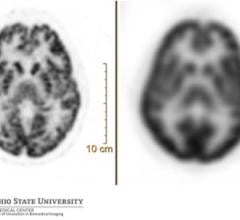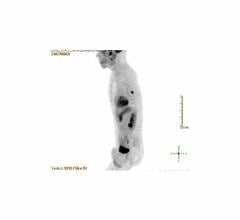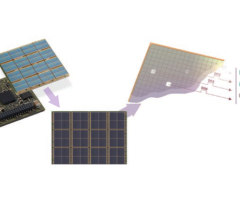February 27, 2014 — People who are dementia-free but have two parents with Alzheimer's disease may show signs of the ...
PET Imaging
Positron emission tomography (PET) is a nuclear imaging technology (also referred to as molecular imaging) that enables visualization of metabolic processes in the body. The basics of PET imaging is that the technique detects pairs of gamma rays emitted indirectly by a positron-emitting radionuclide (also called radiopharmaceuticals, radionuclides or radiotracer). The tracer is injected into a vein on a biologically active molecule, usually a sugar that is used for cellular energy. PET systems have sensitive detector panels to capture gamma ray emissions from inside the body and use software to plot to triangulate the source of the emissions, creating 3-D computed tomography images of the tracer concentrations within the body.
The advent of hybrid PET/MR in 2011 brought the promise of vastly improved imaging technology in the form of a new ...
What was once diagnostic imaging is on track to becoming much more. Radiology is on the verge of a new era in which its ...
Digital technology is opening remarkable opportunities for clinical positron emission tomography (PET) about which ...
January 23, 2014 — An international research team at Icahn School of Medicine at Mount Sinai is testing a sugar-based ...
December 24, 2013 — GE Healthcare showcased at the Radiological Society of North America Annual Meeting (RSNA 2013) a ...
The pursuit of an imaging tool to visualize the protein alpha-synuclein, the hallmark pathology of Parkinson's disease ...
Precision can have an enormous impact on patients. From diagnosis to patient monitoring (see “How Digital PET/CT Can ...
Piramal Imaging announced today the European Union's Committee for Medicinal Products for Human Use (CHMP) recommended ...
December 13, 2013 — Philips unveiled the Vereos PET/CT fully digital positron emission tomography/computed tomography ...
Greg Freiherr speaks from the show floor on day three of the 2013 annual meeting of the Radiological Society of North ...
PET is getting ready to venture outside oncology, cardiology and mainstream neurology. High on the list of new clinical ...
December 3, 2013 — Imaging with the molecular imaging tracer 18F-FDOPA can help distinguish radiation-induced lesions ...
November 25, 2013 — The global market for medical imaging devices is estimated to be at $30.2 billion, forecast to be ...
November 20, 2013 — The Society of Nuclear Medicine and Molecular Imaging (SNMMI) announced that the U.S. Food and Drug ...
Analog is approximate. Digital is specific. Therein lies the fundamental difference between digital PET and its analog ...
November 8, 2013 — Zevacor Molecular, a healthcare firm that manufactures and distributes positron emissions tomography ...
October 25, 2013 — The U.S. Food and Drug Administration (FDA) today approved Vizamyl (flutemetamol F 18 injection), a ...
October 22, 2013 – Nuclear Imaging Services LLC (NIS) has completed the first U.S.-based ECAT Scintron installation into ...
October 21, 2013 — Jefferson Medical College researchers have developed a hologram-like display of a patient’s organs ...
October 10, 2013 — Advanced imaging with Positron Emission Tomography (PET) scans shows promise in predicting which ...
October 9, 2013 — Each year, 13 percent of all newly diagnosed lung cancer patients are diagnosed with small-cell lung ...
October 7, 2013 — Claron Technology will announce extended modality support for its Nil universal zero-footprint medical ...
October 3, 2013 — The Alzheimer's Association is disappointed by the Centers for Medicare & Medicaid Services (CMS) ...


 February 27, 2014
February 27, 2014 















